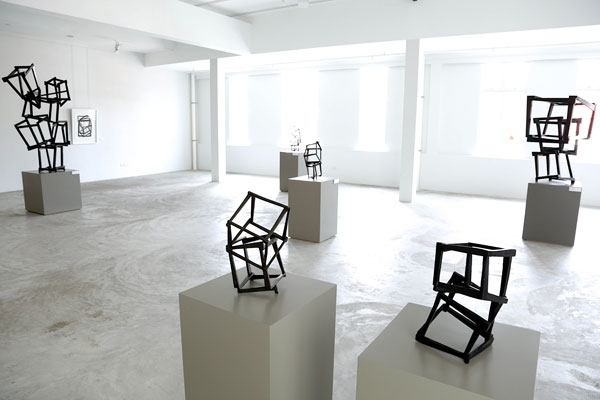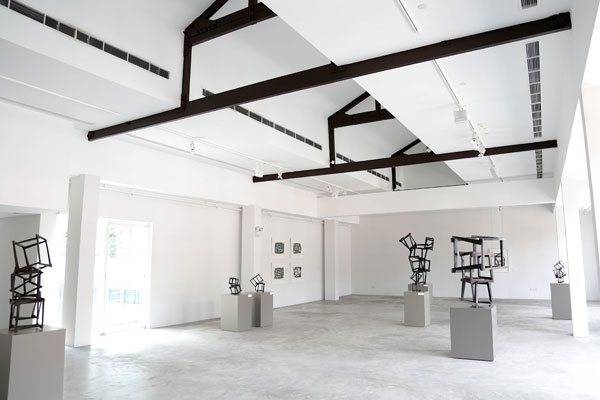In the latest Art Salon talk, organised by Art Stage Singapore, panellists deliberate on the conflicting relationship between art and architecture and the future of creative expression in contemporary urbanity, writes Olha Romaniuk.

November 18th, 2014
Top image: Jedd Novatt solo exhibition, Art Plural Gallery. Photo courtesy of Art Plural Gallery
The question of whether art and architecture can harmoniously coexist with one another was a hot topic of conversation during the latest Art Salon talk titled “Art and Architecture – A Difficult Marriage?” at Art Plural Gallery. The talk, launched by Art Stage Singapore as part of an on-going effort to foster dialogues on socio-political and cultural issues, brought together industry experts that included artist Jedd Novatt, architect Tan Hock Beng (principal of MAPS Design) and property developer Bill Cheng, and provided eye-opening views into the roles of art and architecture within the contemporary urban context. Moderated by Art Stage Singapore’s founder and director Lorenzo Rudolf, the discussion shed light on numerous topics ranging from the value of integrating art into architecture and into new real estate developments, to the notions of art and architecture as separate but similar pursuits, and to the future of public art in Singapore.

Jedd Novatt solo exhibition, Art Plural Gallery. Photo courtesy of Art Plural Gallery
The conversation that took place around Jedd Novatt’s exhibition of architectural sculptures commenced with the speakers’ ruminations on whether art and architecture are amicably coexisting or competing with each other, with art becoming increasingly sculptural and architecture often crossing over into the artistic realm. The conflicted relationship between the two professions was discussed specifically in the context of museum architecture, with Rudolf pointing out examples like Frank Gehry’s Guggenheim in Bilbao – a strong sculptural museum that arguably overshadows some of the art housed within it.
Though opinions ranged across the board, artist Novatt did not see the trend of blurring lines between art and architecture as troubling or threatening to art as a professional pursuit. “I don’t think of art as competing with museum architecture. Buildings built by starchitects naturally receive more attention but both art and architecture are still experienced as a whole. There is no need for competition; it is about finding an engaging dialogue between the two disciplines,” he acknowledged.
Indeed, the discussion’s progression from dissecting the differences between art and architecture to a conversation about the two disciplines’ place in today’s urban centres reconfirmed the importance of both in the contemporary public spheres of the global cities. To Rudolf’s question – “How important is it for a city to have art in public spaces?” – the panel’s speakers voiced their agreement on the integral role of art and architecture in the urban realm, a role to be advocated as part of an overall urban experience and to be proactively supported by government programmes to truly bridge the gap between artists, architects and developers.
In fact, the latter part of the Art Salon talk highlighted that any disparities between art and architecture paled in comparison to the legislative hurdles faced by developers when trying to integrate artistic expression into any project with budgetary restraints. Cheng saw art and architecture as distinctly different, with one being characterised by functional, structural features – a necessity for urban living – and the other serving a more aesthetic purpose. “In the scheme of building capital value, it’s a function of what percentage of the overall budget is dedicated to the artistic value,” commented Cheng on the practicality of integrating art into new developments.
Despite the budgetary obstacles, Tan saw creative expression and public art becoming more and more important, especially within younger countries, still in the formative stages of building their own character and national identity. “For a young country like Singapore, for example, this push for creating iconic art and iconic buildings is a way of creating an identity,” said the architect. “Many times you see that these ‘iconic’ projects might be too forced or happen too fast, then the effort falls short of the original idea.”
To wrap up the evening’s talk, Rudolf provided the audience with food for thought about the rapidly developing contemporary cities and the increasing importance of artists and architects in shaping the cities of the future. “Art and architecture may be in a difficult marriage,” stated Rudolf, “but they can still have a great conversation with each other.”
With the encompassing conclusion on facilitating and raising awareness about the importance of art and architecture, Rudolf also provided a fitting summary to The Art Salon series’ overarching mission – to continue to create a common platform for conversation about art, design and creativity in Southeast Asia and beyond and to make artistic expression a part of everyday life.
A searchable and comprehensive guide for specifying leading products and their suppliers
Keep up to date with the latest and greatest from our industry BFF's!

Suitable for applications ranging from schools and retail outlets to computer rooms and X-ray suites, Palettone comes in two varieties and a choice of more than fifty colours.

Savage Design’s approach to understanding the relationship between design concepts and user experience, particularly with metalwork, transcends traditional boundaries, blending timeless craftsmanship with digital innovation to create enduring elegance in objects, furnishings, and door furniture.

Channelling the enchanting ambience of the Caffè Greco in Rome, Budapest’s historic Gerbeaud, and Grossi Florentino in Melbourne, Ross Didier’s new collection evokes the designer’s affinity for café experience, while delivering refined seating for contemporary hospitality interiors.

In the pursuit of an uplifting synergy between the inner world and the surrounding environment, internationally acclaimed Interior Architect and Designer Lorena Gaxiola transform the vibration of the auspicious number ‘8’ into mesmerising artistry alongside the Feltex design team, brought to you by GH Commercial.
The internet never sleeps! Here's the stuff you might have missed

London-based Carmody Groarke and Paris-based TVK have been announced as winners of a milestone competition for the new Bibliothèque nationale de France conservation centre.

Artificial intelligence is one of the defining issues of our time. Here are five ideas articles addressing the anxieties and possibilities of the technology in design.